Related Research Articles

Thomas Gainsborough was an English portrait and landscape painter, draughtsman, and printmaker. Along with his rival Sir Joshua Reynolds, he is considered one of the most important British artists of the second half of the 18th century. He painted quickly, and the works of his maturity are characterised by a light palette and easy strokes. Despite being a prolific portrait painter, Gainsborough gained greater satisfaction from his landscapes. He is credited as the originator of the 18th-century British landscape school. Gainsborough was a founding member of the Royal Academy.

The Victoria and Albert Museum in London is the world's largest museum of applied arts, decorative arts, and design, housing a permanent collection of over 2.27 million objects. It was founded in 1852 and named after Queen Victoria and Prince Albert.

Michael Derek Elworthy Jarman was an English film director, stage designer, author and gay rights activist.
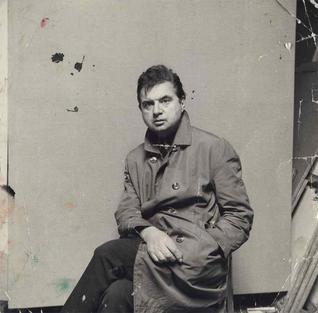
Francis Bacon was an Irish-born British figurative painter known for his raw, unsettling imagery. Focusing on the human form, his subjects included crucifixions, portraits of popes, self-portraits, and portraits of close friends, with abstracted figures sometimes isolated in geometrical structures. Rejecting various classifications of his work, Bacon said he strove to render "the brutality of fact." He built up a reputation as one of the giants of contemporary art with his unique style.
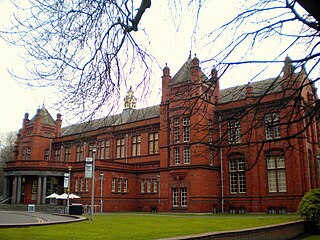
The Whitworth is an art gallery in Manchester, England, containing about 55,000 items in its collection. The gallery is located in Whitworth Park and is part of the University of Manchester.

Levina Teerlinc was a Flemish Renaissance miniaturist who served as a painter to the English court of Henry VIII, Edward VI, Mary I and Elizabeth I. She was the most important miniaturist at the English court between Hans Holbein the Younger and Nicholas Hilliard. Her father, Simon Bening was a renowned book illuminator and miniature painter of the Ghent-Bruges school and probably trained her as a manuscript painter. She may have worked in her father's workshop before her marriage.
Eileen Cooper is a British artist, known primarily as a painter and printmaker.
Patrick Procktor was a British painter and printmaker.

Jeremy Gardiner is a contemporary British landscape painter.
Victor Arthur James Willing was a British painter, noted for his original nude studies. He was a friend and colleague of many notable artists, including Elisabeth Frink, Michael Andrews and Francis Bacon. He was married to Portuguese feminist artist Paula Rego.
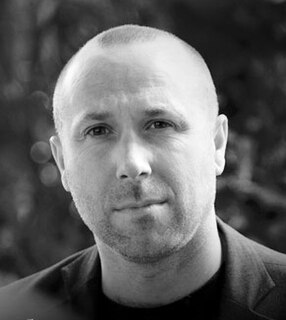
Robert Priseman is a British artist, collector, writer, curator and publisher who lives and works in Essex, England. Over 200 works of art by Priseman are held in art museum collections around the world including the V&A, Museum der Moderne Salzburg, Art Gallery of New South Wales, Musée de Louvain la Neuve, The Royal Collection at Windsor Castle, The Allen Memorial Art Museum, The Mead Art Museum, Honolulu Museum of Art and The National Galleries of Scotland.
Celia Paul is an Indian-born British artist.
Richard Buckner, was an English portrait painter.
George Hooper was a British artist who worked in a unique style informed by Fauvism and the Bloomsbury Group although his style varied greatly throughout his long career. Hooper was born on 10 September 1910 in Gorakphur, India and died on 18 July 1994 in Surrey, England. During World War II He was invited to join Kenneth Clark’s Recording Britain scheme as one of a small group of artists commissioned to create works that would, “...boost morale by celebrating the country’s natural beauty and architectural heritage”. He taught at Brighton College of Art and works of his are in the Victoria and Albert Museum, The British Museum and a number of smaller galleries in Sussex. He spent most of his later life in Redhill in Surrey painting largely independently of any school or group of artists. He married Joyce Katherine Hooper MBE in 1941.

Portrait of Isabel Rawsthorne Standing in a Street in Soho is a 1967 oil on canvas painting by the British figurative artist Francis Bacon, housed in the Neue Nationalgalerie, Berlin. Described by art critic John Russell as one of Bacon's finest works, it depicts Isabel Rawsthorne, the painter, designer and occasional model for artists such as André Derain, Alberto Giacometti and Picasso.
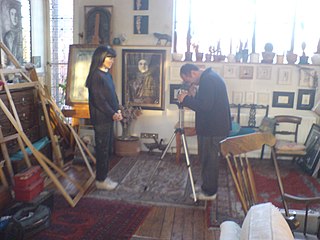
Clare Noel Shenstone is an English artist. She is considered notable for her cloth relief heads and her figure drawings. Her portraits hang in some major British collections including the National Portrait Gallery and the Sainsbury Centre for Visual Arts.
Armet Francis is a Jamaican-born photographer and publisher who has lived in London since the 1950s. He has been documenting and chronicling the lives of people of the African diaspora for more than 40 years and his assignments have included work for The Times Magazine, The Sunday Times Supplement, BBC and Channel 4.
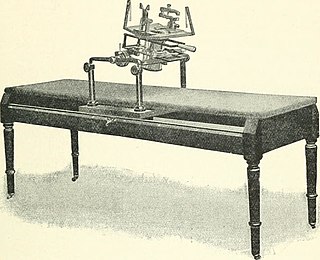
The radiography of cultural property is the use of radiography to understand intrinsic details about objects. Most commonly this involves X-rays of paintings to reveal underdrawing, pentimenti alterations in the course of painting or by later restorers, and sometimes previous paintings on the support. Many pigments such as lead white show well in radiographs.
Ella and Nelia Casella were British artists, sculptors, and medalists, known for their collaborative work. Both sisters worked frequently in wax, creating portraits which are now held by the Victoria and Albert Museum. They worked together on a variety of illustrations and medal commissions.
References
- ↑ "'When Bacon is in your bloodstream he never leaves you', 24 August 2015, Today - BBC Radio 4". BBC. Retrieved 4 March 2018.
- 1 2 Peter Conrad (10 August 2008). "The power and the passion". The Observer. Retrieved 3 March 2018.
- 1 2 Christopher Howse (13 November 1993). "Beautiful Wounds". The Spectator. Retrieved 3 March 2018.
- ↑ "Flesh and Bones Unites Oxford and Chichester – Toovey's Blog". blog.tooveys.com. Retrieved 4 March 2018.
- ↑ Iain Gale (28 March 1994). "The word made flesh: Michael Clark's paintings of wounds are now on display at Chichester Cathedral. Iain Gale views his 'conceptual Crucifixion'". The Independent. Retrieved 3 March 2018.
- ↑ "The Influencers: February 2015". Axisweb. Retrieved 3 March 2018.
- ↑ "For Derek". Colour/ "Chroma". 31 January 2012. Retrieved 3 March 2018.
- 1 2 National Portrait Gallery. "Derek Jarman ('Seer')". www.npg.org.uk. Retrieved 6 March 2018.
- ↑ Glossary of art terms. "Assemblage". National Portrait Gallery.
- 1 2 National Portrait Gallery. "Nicholas Roeg ('al-jebr')". www.npg.org.uk. Retrieved 6 March 2018.
- ↑ Harriet Lane (29 January 2006). "Harriet Lane reveals passions beneath calm exterior of Miss Valerie Beston, Francis Bacon's trusted gallery administrator". the Guardian. Retrieved 6 March 2018.
- ↑ Christie's International Media Division (February 2006). "The Collection of The Late Miss Valerie Beston: Artists from the London School". Auction Catalogue: 72.
- ↑ Michael Peppiatt, Michael (2015). Francis Bacon in Your Blood. UK: Bloomsbury Circus. ISBN 978-1408856246.
- ↑ Victoria & Albert Museum. "Study for Reece Mews Interior (Francis Bacon's Studio)". collections.vam.ac.uk. Retrieved 2 March 2018.
- 1 2 British Museum. "Drawing of Francis Bacon". British Museum. Retrieved 3 March 2018.
- ↑ Victoria & Albert Museum. "Untitled Wound". collections.vam.ac.uk. Retrieved 3 March 2018.
- ↑ Samantha Manton (2016). "The Gardener Digs in Another Time" (PDF).
- 1 2 P.N.Moore (2015). The Bullet Point Book of Chichester Art. Chichester, United Kingdom: Rivers Books. pp. 17–19. ISBN 978-0954306489.
- ↑ "Take a Deep Breath symposium audio recordings | Tate". www.tate.org.uk. Retrieved 4 March 2018.
- ↑ "Ears Have Walls: On Hearing Art - Steven Connor". stevenconnor.com. Retrieved 4 March 2018.
- 1 2 Victoria & Albert Museum. "Every Man and Every Woman is a Star (Sculpture)". collections.vam.ac.uk. Retrieved 1 March 2018.
- ↑ "Beautiful Dreamer: Perhaps Eye Sleep and Dream U - Taster". Vimeo. Retrieved 1 March 2018.
- ↑ "Collection search: You searched for michael clark". British Museum. Retrieved 6 March 2018.
- ↑ "Michael Clark - Person - National Portrait Gallery". www.npg.org.uk. Retrieved 6 March 2018.
- ↑ "The new-look Whitworth Art Gallery: Director Maria Balshaw on the £15 million development | Culture24". www.culture24.org.uk. Retrieved 6 March 2018.
- ↑ "Explore the Royal Collection Online". www.royalcollection.org.uk. Retrieved 6 March 2018.
- ↑ "Museum of London | free museums in London | things to do in London". collections.museumoflondon.org.uk. Retrieved 6 March 2018.
- ↑ "Michael Clark (b.1954) | Art UK". www.artuk.org. Retrieved 6 March 2018.
- ↑ "Michael Clark, Portrait of Philip Stroud". Pallant House Gallery Magazine 15. 21 June 2008. p. 52. Retrieved 6 March 2018.
- ↑ Victoria & Albert Museum. "Every Man and Every Woman is a Star (drawing)". collections.vam.ac.uk. Retrieved 6 March 2018.
- ↑ Victoria & Albert Museum. "Search the Collections - Michael Clarke". collections.vam.ac.uk. Retrieved 6 March 2018.
- ↑ Gagosian Gallery (Ed.) (2015). Francis Bacon: Late Paintings. Gagosian Gallery. p. 108. ISBN 978-0-8478-4775-4.